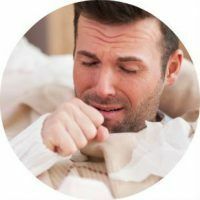
Mucolytics are the means that help cope with dry cough, the action of which is aimed at diluting the thick sputum secreted by the respiratory system. The list of drugs in this group is large enough, and each of them has different mechanisms of action, so the drugs should be prescribed by the doctor, based on the cause and severity of the disease.
- How to use
- How to use
- How to use
- How to use
- How to use
- Classification
- Vegetable origin
- Bronchicum C( Tussamag)
- Linkas
- Mukaltin( Mukaltina tablets, Mukaltin-Lect, Alteika)
- Proscan( Gerbion, Gedelix, Prospan SASHE)
- Sinupret
- Licorice root liquor Syrup( Licorice syrup)
- Synthetic
- ACS( Fluimucil, Miconone, Acetylcysteine Sodium)
- Bromhexine( Bromhexine-Acrychin, BromHexin MS, Solvin, Bromgexin-Aegis)
- Carbocysteine (Fluidite, Libexin Muko, Bronhobos, Fluviert, Mucosol)
- Lazolvan( Ambroxol, Ambrobe, Flavamed, Bronchor)
- Trypsin crystal
- For children
- In pregnancy
Usage methods
Mucolytic drugs are manufacturedin the form of syrups, tablets, solutions, capsules and granules. The choice of medication and its form is determined by the age of the patient and the severity of the disease.
- Granules and effervescent tablets based on acetylcysteine dissolve in water and are taken within half an hour after meals.
- Tablets with ambroxol are washed down with a large amount of water, a syrup with the same ingredient is consumed while eating.
- Capsules containing carbocisteine in them are swallowed whole, immediately after ingestion.
- Bromgesskin in the form of tablets and syrup is taken 3 times a day and is abundantly washed down with water.
Mucolytics are administered orally and in the form of inhalations.
to contents ^Difference from thinners
Medicines for treating a cough are divided into three groups: mucolytics, antitussives and expectorants. Drugs of different groups differ in their effects, and therefore do not combine and are used in different situations.
Antitussive drugs, unlike mucolytic drugs, help with dry and unproductive cough, which can be caused by tobacco smoke, dust, rhinitis with leakage of excreted sputum into the bronchi, reaction to inhaled oxygen or after taking some medicines.
With the help of expectorants, the work of ciliated epithelium, responsible for the amount of secreted bronchial secretions, is restored and the sputum is evacuated from the respiratory tract. Drugs of this group, in contrast to the previous two, are used as ancillary in a complex of antimicrobial therapy. They do not eliminate the cause of the cough, but they facilitate the patient's condition.
to contents ^Indications
Mucolytic drugs are prescribed for the treatment of:
- of acute and chronic bronchitis;
- of bronchial asthma;
- of pulmonary tuberculosis;
- of a smoker's cough;
- acute and chronic pneumonia.
Drugs effectively cope with dry cough, turning it into a damp and productive. Throughout the course of treatment, tablets and capsules should be drunk abundantly with water, weak tea, mors, or compote.
to contents ^Restrictions on the use of
- It is not recommended to combine mucolytic agents with antitussive, since they have exactly the opposite effect.
- Mucolytics are not suitable for the treatment of wet cough, because they increase the production of sputum even more.
- When allergic reactions or individual intolerance of components appear, the prescribed drugs are canceled or replaced by others.
- Drugs are not used to treat addicted people.
Side effects of
- Bronchospasm.
- Allergic reactions.
- Hemoptysis due to damage to the mucous membrane of the respiratory tract.
- Appearance of dependence on drugs containing codeine.
- Indigestion and so on.
Classification of
Mucolytics are divided into types according to the effect:
- affecting the viscosity of secretion;
- sputum-promoting phlegm;
- reducing the amount of sputum in the respiratory system.
They are also subdivided by the method of affecting the direct( destroying polymeric mucus bonds) and indirect. The latter include drugs that alter the biochemical composition of sputum, increase the activity in bronchial glands, affect hydration, stimulate the gag reflex.
The composition of medicines are of plant origin and synthetic.
to the table of contents ^Vegetable origin
Traditionally, they include plant extracts, dry medicines, oils, herbal preparations. Mucolytics of this group have fewer side effects than preparations of artificial origin. They have anti-inflammatory properties, reduce mucosal edema and facilitate sputum evacuation. Each component of the drug purposefully affects the respiratory tract, for example, thyme removes perspiration and hoarseness, and the extract of ivy leaves exerts an expectorant effect.
to contents ^Bronchicum C( Tussamag)
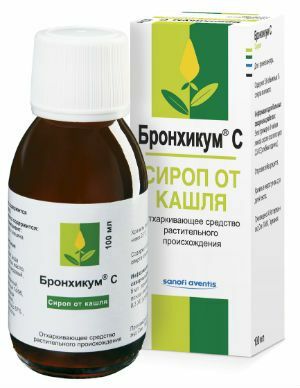
The active ingredient is an extract of thyme grass. Produced in the form of syrup, troches, elixir.
Has an expectorant effect, removes the mucous membrane of the bronchi, reduces inflammation.
Adults and adolescents are advised to take 2 teaspoons of syrup after eating 3 times a day.
Side effects: allergic reactions, nausea, gastritis, dyspepsia.
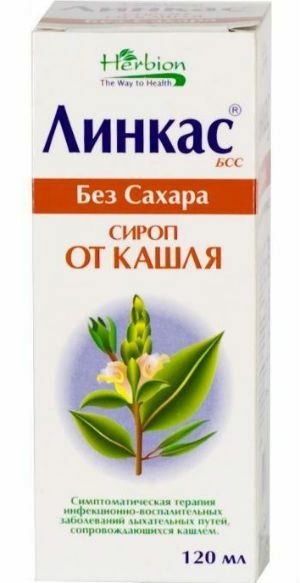
Active ingredients - dry extracts of leaves of vascular adatodes, roots of naked licorice, fruits and roots of long pepper, fragrant violet flowers, leaves of medicinal hyssop, roots and rhizomes of alpinia galanga, flowers of althea officinalis, fruits of real jellyfish, leaves andflowers of bracteous onosmy. It is available in the form of syrup, troches, balm, granules for dissolution in hot water.
The drug increases the productivity of cough, has an expectorant and mucolytic effect.
Children from 6 months to 3 years are prescribed 0.5 teaspoonful 3 times a day, children from 3 to 8 years - 1 teaspoon 3 times a day, children under 18 years - 1 teaspoon 4 times a day. Dosage for adults is 2 teaspoons 3-4 times a day. The course of treatment lasts 5-7 days.
Side effects: allergic reactions.
Mukaltin( Mukaltina tablets, Mukaltin-Lect, Alteika)
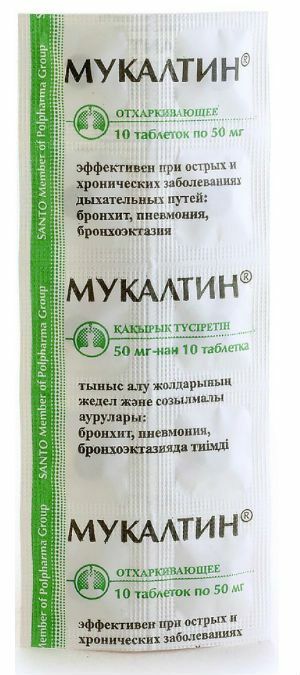
Active ingredient - althea medicinal herb extract, is available in tablets.
It is prescribed for treatment of laryngitis, tracheitis or bronchitis individually depending on the characteristics of the disease and age.
Side effects: allergic reactions.
Propane( Herbion, Gedelix, Prospan SASHE)
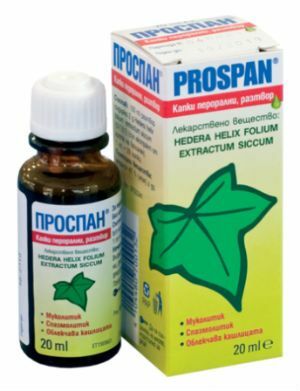
Active ingredient is an extract of ivy leaves. Available in the form of drops and syrup.
The drug is effective for acute and chronic inflammation of the respiratory tract, accompanied by a cough with hard-to-recover sputum.
The dosage of syrup for infants up to 1 year is 2.5 milliliters 2 times a day, for children aged 1 to 6 years, 2.5 milliliters 3 times a day, for teenagers and school-age children 5 milliliters 3 timesin a day. Adults are assigned 5-7.5 milliliters of syrup 3 times a day. The duration of treatment depends on the severity of the disease.
Side effects: allergic reactions, a laxative effect is possible.
Sinupret
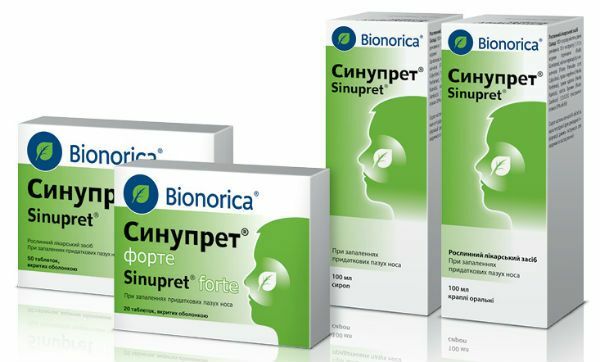
Active ingredients - gentian root, primrose flowers, sorrel grass, elderberry flowers, verbena grass. Produced in the form of drops, drops for oral administration.
The drug has a mild effect and is easily tolerated. Thanks to herbal components, the drug helps to quickly remove sputum from the nasal sinuses and upper respiratory tract.
Adults are given a dosage of 2 tablets 3 times a day, school-age children - 1 dragee 3 times a day. The course of treatment lasts from 7 to 14 her. During pregnancy, the medicine is administered only as directed by the doctor.
Side effects: allergic reactions, digestive disorders.
Licorice root syrup( licorice syrup)
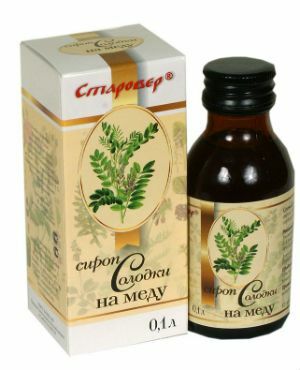
Active substance - licorice roots.
The product is intended for the treatment of diseases of the upper respiratory tract. Has an expectorant effect, also acts as an anti-inflammatory, immunostimulating, regenerating and antiviral drug.
The medicine is taken 1 tablespoon 3-5 times a day.
Side effects: increased blood pressure, the appearance of edema.
Synthetic
The components of these preparations are obtained by synthesizing, with their help, sputum evacuation is facilitated and facilitated. They also have a counter-toxic effect and regenerate the sectoral cells of the bronchi.
to table of contents ^ACS( Fluimutsil, Mukonex, Acetylcysteine Sodium)
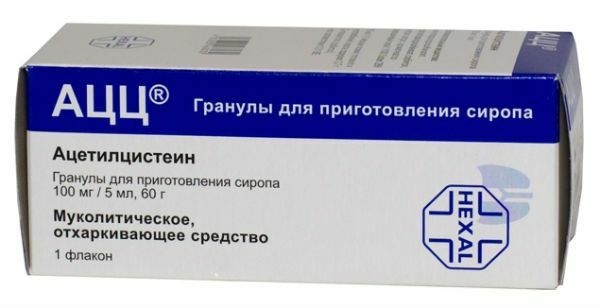
The active ingredient is acetylcysteine. Produced in the form of syrup, effervescent tablets, granules for dissolution, solution for injection.
Indicated for diseases of the respiratory system, accompanied by a thick, difficult to separate sputum.
Daily dose for the treatment of adults and children from 14 years to 400-600 milligrams.
Side effects: allergic reactions, lowering blood pressure, tinnitus, nausea.
Bromhexine( Bromhexine-Acryxin, Bromhexine MS, Solvine, Bromhexine-Aegis)
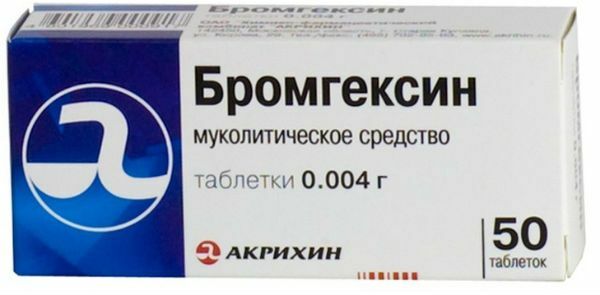
The active ingredient is bromhexine. Produced in the form of tablets, syrup and solution.
The drug is effective in tracheobronchitis, chronic bronchitis, bronchial asthma and chronic pneumonia.
Adults and children over 10 years of age are prescribed 8 milligrams 3-4 times a day, children under 2 years of age - 3 milligrams 3 times a day, children from 2 to 6 years - 4 milligrams 3 times a day and 6 to 10years - 6-8 milligrams 3 times a day. During pregnancy, the medicine is administered only as directed by the doctor.
Side effects: headache, dizziness, sweating, skin rash.
Carbocysteine (Fluidite, Libexin Muko, Bronhobos, Fluviert, Mucosol)
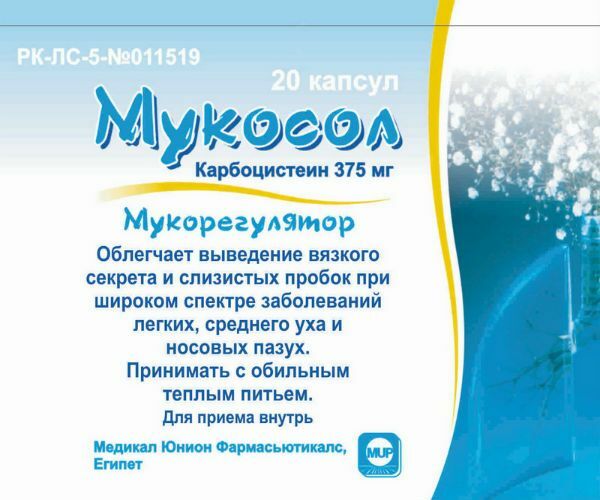
The active ingredient is carbocysteine. Available in the form of capsules and syrup.
Helps reduce mucus formation and changes its biochemical composition. The drug activates the production of enzymes in the cells of the bronchial mucosa, and also helps restore the mucosa after bronchitis.
Adults take 2 capsules 3 times a day, children under 2 years of 0.5 teaspoon of syrup 4 times a day, children under 12 years - 2 teaspoons 3 times a day. The course of treatment lasts 8-10 days. With caution is prescribed during pregnancy, during treatment during lactation it is necessary to stop breastfeeding.
Side effects: nausea, diarrhea, gastrointestinal bleeding, headache, skin rash.
Lazolvan( Ambroxol, Ambrobe, Flavamed, Bronhorus)
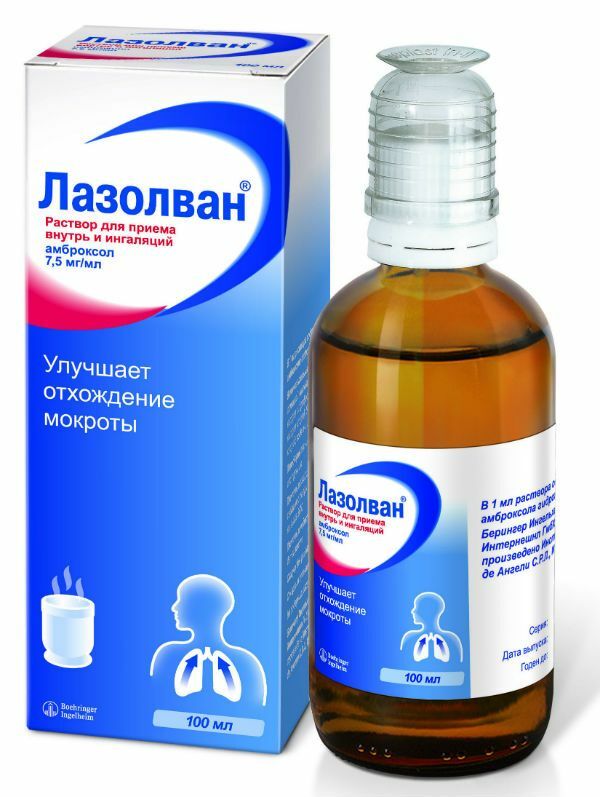
The active substance is ambroxol. Produced in the form of tablets, syrup and solution for injection.
The drug is effective for acute and chronic diseases of the respiratory system with dry non-productive cough, coughing of a smoker.
The drug is taken 1 tablet 3 times a day. With caution is prescribed in the 2nd and 3rd trimester of pregnancy.
Side effects: nausea, rash, anaphylactic reactions.
Trypsin crystalline
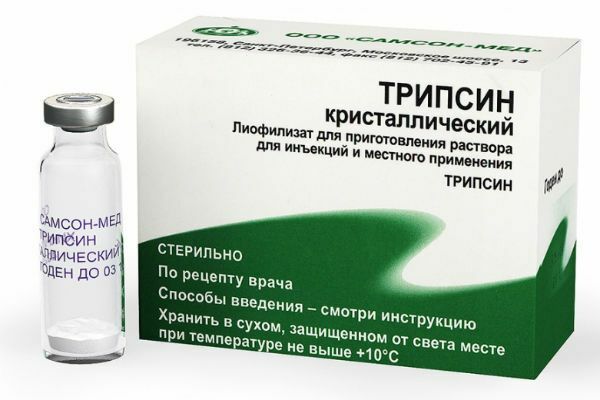
The active ingredient is trypsin.
Has a liquefying effect on viscous sputum secreted by respiratory system. The solution is administered intramuscularly or interpreterally with the help of aerosols and sprays.
Adults are assigned 0,005-0,01 grams 1-2 times a day, the child - 0,0025 grams 1 time per day. After inhalation, the mouth should be rinsed with warm water and the nose rinsed. During pregnancy, it is only used as directed by the doctor.
Side effects: allergic reactions, fever, pain at the injection site.
For children
Children's preparations for dry cough are appointed with extreme caution. For example, drugs containing codeine are prohibited for the treatment of children under 2.5 years of age. To small patients the soft preparations prepared on the basis of grasses will approach.
Well helps with cough chest picks, as well as various inhalations, especially with soda. They actively moisturize and soften the baby's airways, making it easier to cough. The most suitable form of medicine for a child is syrup. Pleasant to taste and consistency, it does not cause dislike in the child.
When pregnant
Medicines for treating a cough duringpregnancy should prescribe only a doctor. The safest are the drops and elixir Bronchicum, licorice syrup, Bromhexine, Ambroxol and Carbocysteine.
The course of treatment will be more effective if you follow certain rules. For example, drink more warm liquids( tea, milk or compote), do respiratory gymnastics, do inhalation as directed by a doctor, avoid inhaling cold air and supercooling if possible.
